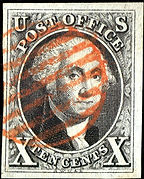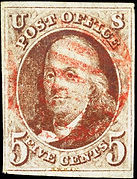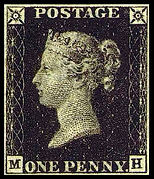
CYPHER STAMP CLUB
Colorado Young Philatelic Explorers and Researchers
Sponsored by the Rocky Mountain Philatelic Library
2038 S. Pontiac Way, Denver, CO 80224




Rare Stamp Stories
The 1857 Tiflis Stamp

What can we say about this little stamp? It is one of the more interesting looking rare stamps in the world. It is one of the oldest surviving stamps from the Russian Empire, originating from the city of Tiflis, now part of the country of Georgia.
Printed on a metallic sheet with embossed lettering it looks more like an ornamental design found on a book, ceiling, or paneling.
Until 2014, there were only five examples known. A collector in New Zealand purchased an old collection of stamps at an auction for about $2,500. While going through the album he discovered this unusual stamp and it took almost three years for the stamp to be certified as genuine. The collector sold the stamp at auction in 2017 for $215,000, quite a nice profit. The collectors discovery of this stamp brought the total to six known examples.
The United States 1867 3 cent Washington with “B” Grill


Most people have stamps that look just like this in their collection. If it looks as bad as this one does it is most likely lying in the bottom of a cigar box, maybe a shoe box full of duplicates in glassines. Grills were used on stamps in the 1860’s through 1870’s to prevent fraud. People soaked the stamps off envelopes, cleaned the cancellations, and then reused the stamps.
Until 1969 this stamp was unknown, four examples were found on this cover to Germany. The cover sold at auction and the winning bidder removed the stamps, eventually selling them as single examples. In 1993, an example (third stamp from the left) sold for $85,000.
This ugly duckling of a stamp (single stamp to the far left), off center, with nibbled untidy perforations, rounded corners, and an unattractive cancel, sold for $1,035,000 at the October 29, 2020, Robert Siegel Auction.
The United States 1869 24 cent Declaration of Independence Invert
In 1869, the United States issued a set of 10 stamps. The 15 cent through 90 cent values were printed in two colors. They were the first bi-colored stamps issued by the United States.
The 24 cent stamp is highly sought after just because it is a work of art. The stamp features a central image of a painting by John Trumbull, “The Presentation of the Declaration of Independence.” The engravers were able to fit 42 individual figures in the central vignette, many are so small they can only be seen with a magnifying glass.
During the printing of the stamps a number of sheets of the 15, 24, and 30 cent values were released with the central image up-side-down. These invert error stamps command premium prices at auction.
The stamp show here sold at a Weiss Auction on February 9, 2008, for the princely sum of $1.2 million dollars.


The United States 1918 Inverted Jenny
The United States printed it’s first airmail stamps in May, 1918. On the morning of May 14, William Robey, an avid stamp collector went to a post office in Washington, D.C., to purchase the new stamp. The sheet of stamps he purchased were printed with the airplane up-side-down. Robey later wrote, “When the clerk brought out a sheet of inverts, my heart stood still.” He paid for the sheet, and asked to see more, but the remainder of the sheets were normal. The postal clerk who sold the sheet later said he did not realize the image was inverted because he had never seen an airplane before. Just one sheet of 100 stamps was discovered with the inverted plane.
Robey sold the sheet of stamps to a dealer, Eugene Klein, for $15,000, and Klein in turn sold the sheet of stamps to collector “Colonel” H.R. Green for $20,000. Before selling the stamps Klein penciled the plate number position of each stamp on the reverse. These pencil marks remain on the stamps to this day and have made it easy to identify what position each stamp had in the original sheet. Colonel Green broke up the sheet of stamps and sold the individual stamps, and blocks, over a period of time.
This example of the rare stamp sold for almost $1.6 million dollars in November 2018.
Baden - the 1851 9-Kruezer Color Error


In 1851, Baden (a German state) issued a set of postage stamps. The 9 Kruezer stamp was printed in black on pink paper, the 6 Kruezer stamp was printed in black on green paper.
In 1894, more than 40 years after the stamp was printed, a collector in Germany found an example of the 9 Kruezer stamp printed on green paper. The collector, a member of the philatelic club of Berlin showed it to another member, Baron von Türckheim who showed the stamp to his father and discovered that he had two copies of the stamp on letters in his possession! This incredible coincidence accounts for more than half of the known copies in the world. Until 1919, only three examples were known, one additional copy was found in later years.
In 2019, a collector in the United States was going through a stamp collection he inherited from his grandmother many years ago. He started working on the German stamps and came across an example of the 9 Kruezer on green paper stamp. He thought it was a forgery but decided to go ahead and send the stamp in for expertizing. Six weeks later he received news that his stamp was now the fifth known example. The collector sold the stamp at private auction.
In July 2019, an example of this stamp, on cover, sold for $1.73 million dollars.
The 1851 Hawaiian Missionaries

Hawaiian Missionaries is the nickname given to the first stamps issued by the Kingdom of Hawaii in 1851, and were used by Christian Missionaries. They were issued in 2, 5 and 13-cent values and were printed on very thin paper, easily torn, and most of the stamps did not survive.
In 1870, a factory was shutting down and workers were instructed to burn old correspondence. This cover was packed in a bundle of correspondence that was shoved into the furnace. The bundle was packed so tightly the fire went out. (If you look closely you will see a scorch mark in the center of the left edge of the cover.) The cover sat in the furnace for 35 years before a keen eyed workman discovered the bundle still there. Knowing something about stamps, the workman rescued the bundle, and sold it to a stamp dealer. The stamp dealer sold this cover to collector, Alfred Caspary, in 1917 for $6,100.
The “Dawson Cover” named for the recipient Miss Eliza A Dawson, is the only known example of the 2 cent Hawaiian Missionary stamp on cover. The cover sold at auction in 2014 for $2.24 million dollars.
The 1859 Sicilian Color Error
In 1859 Sicily issued a number of stamps with the image of Ferdinand II. One of the stamps was the 1/2 Grana value, printed in orange. A number of the stamps were mistakenly printed in blue, the color for the 2 Grana stamp.
The error was first shown at the 1899 Manchester (England) Philatelic Exhibition. Emilio Dieno, a collector and dealer, was the first individual to record the stamp as an error.
This is one of two known examples and it is in amazingly good condition considering it is more than 150 years old.
The stamp was sold at auction in November 2011 for $2.6 million dollars. Until 2014 this was the highest price paid for a foreign postage stamp, the 1856 British Guiana 1 cent Magenta stamp sold for $9.48 million in June of that year.


The Swedish 1855 Treskilling Yellow
This is one of the first stamps issued by Sweden in 1855. The three skilling stamp was printed in a blue-green color. A printing error resulted in a number of yellow stamps.
In 1886 a young boy, Georg Wilhelm Backman, was visiting his grandmother’s farm. He collected stamps and was going through old letters in her attic when he came across a cover with a yellow three skilling stamp. George sold the stamp to Heinrich Lichtenstein, a well known stamp dealer for 7 kronor, about .85 cents in todays money.
In 2010, Baron Gunther Andre claimed to have stored nine Treskilling Yellow stamps in a London Bank vault. The vault was allegedly broken into and the stamps were stolen. The Baron filed a lawsuit against the bank, but famous stamp collectors and the court determined it was improbable that many undiscovered stamps were held in the vault and his claim was denied.
Although the stamps were printed in sheets of 100, only one Treskilling Yellow is known to exist. It last sold at auction in 2010 for $2.6 million dollars. Who knows, more could be out there waiting to be discovered.



The United States 1868 1 cent Benjamin Franklin “Z” Grill
The 1 cent Benjamin Franklin “Z” Grill stamp is the most valuable United States postage stamp. The “Z” grill is found on other stamps from 1860’s to the 1870’s. Grilling stamps was an attempt at preventing people from fraudulently cleaning cancellations off of stamps and reusing them. The grills would break the fibers of the stamp paper allowing the cancellation ink to absorb into the paper better and make cleaning nearly impossible. After a number of years experimenting with different types, and sizes, of grills the practice was deemed impractical was discontinued in 1870.
There are two known examples of this stamp. One is in the possession of the New York Public Library as part of the Benjamin Miller Collection.
Donald Sundman purchased his copy of the “Z” Grill in 1998 at a Robert Siegle Auction. Donald’s 11-year old son, Zachary, was responsible for holding the paddle during bidding. Zachary and Donald purchased the stamp for the sum of $935,000.
In October, 2005, Bill Gross, a hedge fund manager and stamp collector traded a block of four Inverted Jenny Stamps for Donald Sundman's “Z” Grill stamp. Bill Gross became the first person in the world to own a complete collection of all United States Stamps issued. The cost of the trade, a cool $3.5 million dollars.
The 1847 “Post Office” Mauritius Stamps


In September 1847, the British Colony Mauritius issued two stamps, an orange-red 1 penny, and a deep blue 2 penny. The nickname comes from the wording used in the left margin on the stamps “Post Office.” In 1848, new stamps were issued where the inscription was changed to read “Post Paid.”
Joseph Barnard engraved the stamps featuring an image of Queen Victoria, he included his initials “JB” which are found in the lower right margin of the portrait. Five hundred copies of each value were, most were used by the Governor’s wife to sendout invitations for a ball planned for the upcoming weekend.
In 1904, the future King of England, George V paid £1,450 for an unused blue Two Pence "Post Office" stamp (about $213,000 in today’s money). This was a world record price at the time. The next day, one of his secretaries commented that "some fool" had paid a huge amount of money for one postage stamp, to which King George replied, "I am that fool.”
In 1993 the cover shown, the only one known with an examples of the 1 and 2 penny stamps, sold for nearly $4 million.
The 1856
British Guiana
1 cent Magenta

In 1856, the British Colony of Guiana (now the country of Guyana) printed a number of 1 cent magenta stamps for use on newspapers. A shipment of the stamps went missing and the Post Office ordered an emergency printing of the stamps. The printer added the image of a small ship to the stamp, it can barely be seen underneath the signature of the postal clerk, E.D. Wright. The image of the ship is the only difference between the emergency printing and the official printing.
In 1873, a 12-year old Scottish boy, Louis Vernon Vaughn, was living in South America. He was going through some of his uncle’s letters when he found the stamp. There was no record of the stamp in his catalog so he sold it to a dealer six weeks later for the astonishing sum of 6 shillings (about $1.50 in todays money).
The stamp has changed hands many times since it was discovered and has increased in value dramatically. The little 8-sided stamp found by a 12-year old boy, sold for about $1.50 in 1873, last sold at auction in June 2014 for the staggering sum of $9.48 million dollars! It is the only known example of the stamp.

